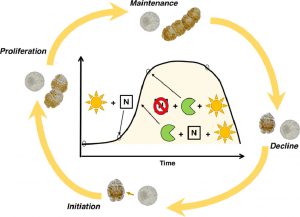Margalefidinium polykrikoides (previously known as Cochlodinium polykrikoides) is a toxic dinoflagellate algae found in Chesapeake Bay. NCCOS sponsored scientists at Old Dominion University used a time-dependent model to assess environmental controls on M. polykrikoides blooms under photosynthetic and heterotrophic nutritional modes as a first step towards development of a tool to predict M. polykrikoides blooms in the lower Chesapeake Bay.

M. polykrikoides is a toxic, fish-killing, mixed-feeding, cyst-forming, dinoflagellate alga found in coastal waters worldwide. Massive, months-long blooms of M. polykrikoides have occurred throughout the lower Chesapeake Bay and its tributaries during most of the past 25 years.
The M. polykrikoides bloom cycle consists of four bloom phases (Figure 1). Initiation of blooms occurs in warm months and has been linked with storm water inputs, storm-induced resuspension of bottom sediment, stratification, and estuarine circulation. Blooms can persist for weeks and extend into early fall. During blooms, M. polykrikoides can represent more than 95% of the algal biomass. The varied biological capabilities of M. polykrikoides (e.g., mobility, mixotrophy, cyst formation) combined with the physical and chemical dynamics of the Chesapeake Bay estuarine systems result in variability in the relative importance of biological versus physicochemical processes throughout the bloom cycle, duration, and magnitude.
The objective of this study was to quantify the relative contributions of cyst dynamics, mixotrophy, and environmental controls, such as irradiance, temperature, and dissolved inorganic nitrogen concentrations, on the duration and magnitude of M. polykrikoides blooms. This objective was addressed using a 3-component time-dependent model that included growth and mortality of algal cells and cysts. The extensive prior field and experimental observations and studies done in the lower Chesapeake Bay and tributaries provided the data for the conceptual model.
Highlights of the study are:
-
-
-
- Cyst excystment (germination) and encystment (dormancy) did not contribute much to bloom magnitude or duration.
- Bloom initiation and timing was regulated by temperature.
- Substantial heterotrophic contribution to growth (mixotrophy) was needed to reach observed bloom magnitudes.
-
-
The study concluded that expanding the M. polykrikoides model framework is necessary to more fully understand and predict bloom development. The M. polykrikoides bloom cycle model is a preliminary step towards development of a tool that can be used to assess and forecast the potential for harmful algal blooms in the lower Chesapeake Bay and how these blooms may be impacted by changing temperatures and other environmental factors.
This study, led by Dr. Eileen Hofmann of ODU, was supported in part by the NCCOS ECOHAB project “Toward a Predictive Understanding of Cochlodinium and Alexandrium Blooms in Lower Chesapeake Bay.” The project leader is Dr. Margaret Mulholland of ODU.
Citation. Hofmann, Eileen E., John M. Klinck, Katherine C. Filippino, Todd Egerton. Brynn Davis, Michael Echevarría, Eduardo Pérez-Vega and Margaret R. Mulholland. 2021. Understanding Dinoflagellate Margalefidinium polykrikoides blooms in Chesapeake Bay. Harmful Algae 107, 102064. https://doi.org/10.1016/j.hal.2021.102064
